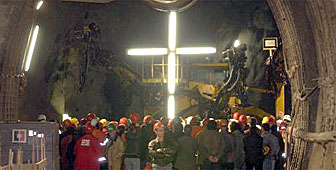Tunnelling for culture

Two of the biggest construction projects in Europe are the subject of a new socio-cultural campaign by the arts council of Switzerland, Pro Helvetia.
When work on them is finished, the new 57-kilometre Gotthard and 35-kilometre Lötschberg tunnels will dramatically shorten the travel time by rail between northern and southern Europe. They will also mark a major step in moves to divert transalpine heavy goods traffic from road to rail, thus making freight transport safer and much more environment-friendly.
But the effects will be more than topographical, economic and environmental. As these huge engineering projects head towards the light at the end of their respective tunnels, Pro Helvetia has begun a “work in progress” on their socio-cultural implications.
The arts council is calling its programme “Gallery” because of the word’s association with both art and tunnelling, and its aim is to involve the local populations at the ends of each tunnel as well as the construction workers.
“Both tunnels are important symbols for Swiss cultural identity,” says Katherine Rieder. “We want to reflect the changes they will bring to the lives of people living in the cantons of Bern and Valais on either side of the Lötschberg, and in Uri, Ticino and Graubünden for villagers affected by the new Gotthard tunnel.”
Public discussions, slide shows and travelling exhibitions are being organised, and Pro Helvetia is encouraging participation by the thousands of tunnel workers – most of them from other parts of Switzerland and abroad – in “Gallery”.
Underground Mass
The feast day of the patron saint of miners, St Barbara, was chosen as the official start of the Pro Helvetia project – and the event was celebrated with a Roman Catholic Mass deep underground.
Rieder says the impact on the lives of local inhabitants will be felt long before the completion of the tunnels. “During construction work,” she told swissinfo, “some villages will see their population doubled because of the temporary presence of the tunnel workers. It’s important that this is seen in a socio-cultural perspective for everyone concerned.”
Both tunnels are part of a major Swiss programme – known by the acronym “NEAT” – to streamline transalpine rail traffic. The bigger of the two is the Gotthard, which will be four times the length of and much deeper than the existing tunnel, built over 100 years ago with the loss of 307 lives.
by Richard Dawson

In compliance with the JTI standards
More: SWI swissinfo.ch certified by the Journalism Trust Initiative
You can find an overview of ongoing debates with our journalists here. Please join us!
If you want to start a conversation about a topic raised in this article or want to report factual errors, email us at english@swissinfo.ch.